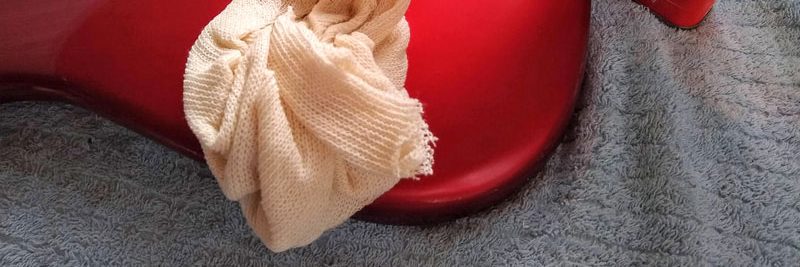
Grain-filling an ash Telecaster body
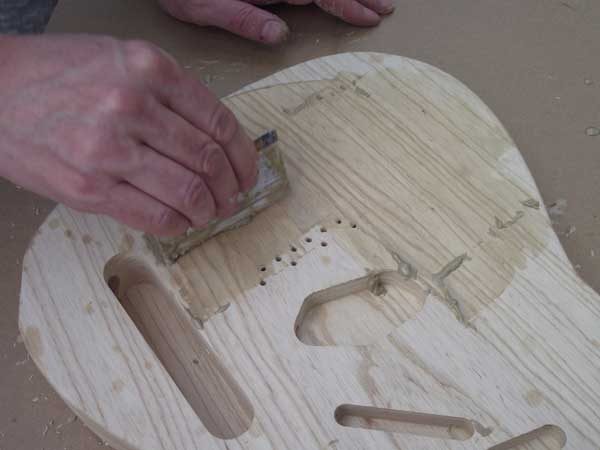
When painting a guitar, preparation is critical to success. At every stage, it’s important that you get the body as smooth as you can. A bit of work early on saves a lot of work later.
Open-pored woods such as ash must be grain filled before lacquer is applied otherwise the lacquer will sink into the grain and it will be very difficult and expensive in lacquer to get a smooth finish.
Grain filler is not the same wood filler and is only for filling pores in the wood so before you start, sand the wood thoroughly to 240 grit or so to remove any scratches and minor imperfections. Bigger imperfections such as holes will need to be filled with wood filler which may mean that a solid colour is your only option.
Once you have your guitar body sanded you can apply the grain filler.
Here, I’m using Rustin’s natural colour grain filler. This works best when thinned to the consistency of double cream so my first step it to do that.
You’ll find that the wood naturally absorbs the solvent so you’ll need to keep adding more in order to keep the correct consistency.
Apply the filler with a squeegee, cloth or your fingers, whichever works best for you, but be sure to pack the filler deep into the wood’s pores. Here I’m using an old credit card. Work along the grain to be sure that the filler is pushed into the pores.
Don’t forget to treat the edges too, as well as inside the cutaways. It’s easy to neglect these areas!
Because the oil-based filler dries slowly, working quickly it’s possible to fill a reasonable area before scraping off the excess. Here, I’ve filled about half the body.
Again, you can use the implement of your choice but here I am using my trusty credit card to remove excess filler. I’m scraping across the grain so that I don’t pull the filler out of the pores.
The more you scrape off at this stage, the less sanding you need to do to remove dried on filler. I find it best to wait an hour or so, when the filler is hard in the pores but still fairly soft on the surface to scrape.
Once you have removed most of the excess filler, you need to leave it to dry over night before sanding.
Sand carefully to 320 grit, using a block and going along the grain so as not to introduce any scratches. You need to get down to the surface of the wood without sanding out the filler that you’ve so just applied.
Sand the edges carefully too and then inspect your work to make sure you’ve done a thorough job.
If you have missed any areas, you’ll need to apply more filler to them.
It really is worth the effort of getting this stage right as everything else depends on having a smooth surface for your lacquer.

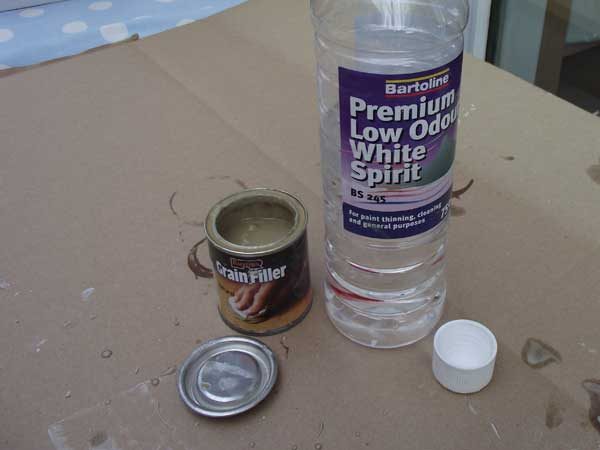
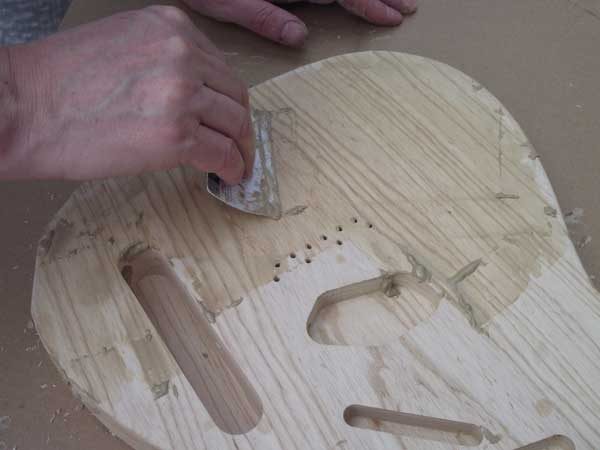

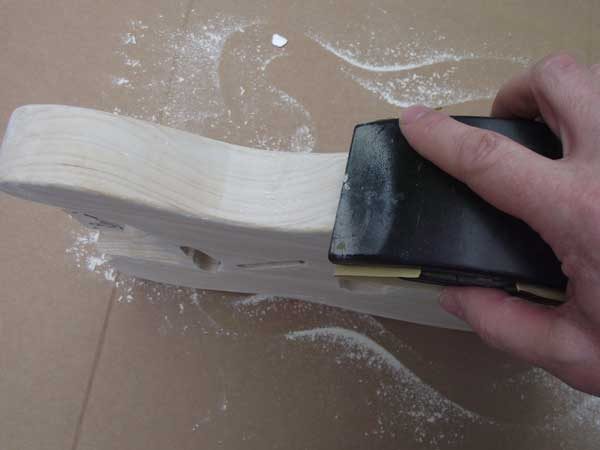
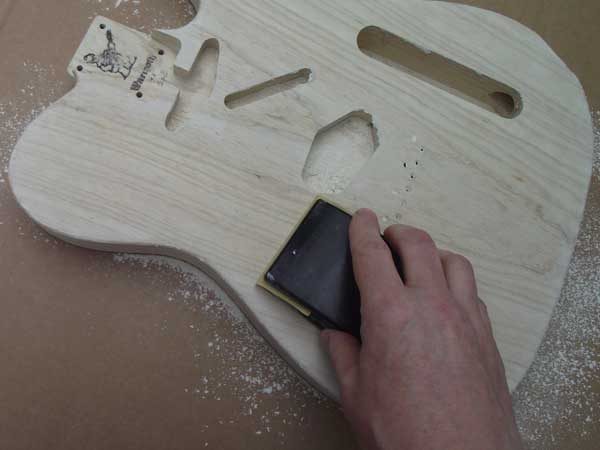
Am just starting my telecaster project. Have grain filled with Rustins product as suggested, and have also now sanded off. Question is – how can I tell when “enough sanding” has been done? Should I be able to feel the open grain still or should the surface be perfectly smooth? Not sure on this point
It should be perfectly smooth so you can’t feel any grain.
The trick is to pack the wood pores with filler then scrape everything off the surface and/or wipe with hessian so that you have to do the bare minimum of sanding. If you leave too much on the surface you have to sand a lot which risks sanding away your grain filler so you have to start again.
It’s normal to have to take a couple of iterations at the filling before it’s right.
Thanks so much for responding. Think I have another grain filler iteration ahead of me before I can start using your products. Best regards. David
Hi Steve: great job and reference point for us “non-professionals” I ask you if the rustins grain filler can be used to stain a mahogany body with water based colors. Usually to close the grain of the wood I use a normal dilute wood putty with a little water, the same procedure that you have very well shown. It would appear that this product you recommend offers better results. Thank you
Rustins grain filler contains the same ingredients as old-fashioned putty – pumice and linseed oil.
It takes stains well once dry or you can mix spirit based stain in with the slurry.
Hi Steve, I am sanding and pore filling some virgin ash telecasters. I’ve tried water based, oil based and finishing epoxy with multiple coats. I’ve had much the same result with all. I get them to where can’t see any open pores until I put white sanding sealer or the color coat after clear sanding sealer then the open pores appear and there are hills and valleys. Am I not sanding enough for the hills and valleys? Am I over sanding after the pore filler or not getting deep enough into the pores?
Thanks in advance!
Jim
I suspect you are over-sanding. You need to apply your grain filler, pressing it into the pores then wipe of all the excess you can so that it only needs the lightest of sanding to remove any that dries on the surface.
The hills and valleys are because the grain varies in hardness and the soft parts sand preferentially. Using a cabinet scraper will help here.
Hi Steve,
Currently working on a DIY kit. I followed this pages advice and grain filled the guitar.
I had some masking tape on the guitar after that from when I was drilling the bridge holes… it left some residue and took some cleaning off!
Long story short, I have now primed the guitar and it looks ok but there’s a couple of bits where I can see grain (where I had cleaned off said residue).
Do you think it would it be okay to use the Rustins Grain Filler over the top of the primer ? Cheers in advance!
Also, forgot to say, if I can use grain-filler over the primer I imagine it would be best to use something other than White Spirit to mix it with.. I’ve got some isopropyl alcohol, do you think that would be better? Thanks!
On a primed surface I think you are better using a white filler such as Ronseal high performance wood filler https://www.ronseal.com/products/high-performance-wood-filler/
It is very fine and sands well. After filling and sanding flat, follow with another coat of primer.
Hi
Minua kiinnostaa tietää, että what is the difference between Ronseal high performance wood filler and Rustin Wood Filler. Can both be used in the same way? Is it possible to use both with Libero’s spirit wood dye and with Libero’s finishing oil, and Liberon Black Bison Wax for example.?
I think that there isn’t much difference between Rustins and Ronseal two-pack wood fillers. Rustins *grain* filler is quite different of course and intended for a different purpose, filling the natural pores in wood, whereas the wood fillers are for filing holes in wood.
I would think that all these will take the Liberon products well (I haven’t used them) but as always, do practice on scrap first!
Ok
Thanks for your answer. I will do some test peace. Maybe I know more then what is different. I believe also it not much….will see
Hi Steve, great resources here.
I’m building a kit and want to get a black stain finish on one section of the body. Should I buy a coloured grain filler, or just try to match the wood colour and then use stain over the top?
I’d grain fill first, assuming the grain filler will accept the stain. Best do a test run I think!
How will you stop the stain bleeding into the wood outside of your selected area?
The rest of the body will be painted with a black glitter finish, so I don’t think I need to worry about stain bleed. I probably do need to think about fractions between the paint and lacquer, and the stain.
Hi, I’m currently refinishing my old strat which I think is an alder body. I have removed the top coat and sanded back to the base wood. Planning to use acrylic paints to put a design on a small part of the guitar then leave the rest with a clear laquer top coat. Would you recommend using this as a base layer before I start the design or something else?
No, grain filler isn’t necessary on alder. The best base I think would be a coat of Sanding Sealer
Thanks Steve. Appreciate the help.
Hey Alex. Planning on a satin finish mahogany body with a thin flame veneer top, stained and then French polished and wax.
The last one I’ve done, I’ve not filled the mahogany at all, just water-based stain followed by the shellac – it’s turned out pretty well. The neck and back of the guitar are gorgeous, although the very end grain on the tail pin end and end of cutaways were a little bit of a bitch to get smooth.
What do you think about only grain filling those parts, so I don’t waste as much shellac closing up those thirsty holes? And if so, should I stain before or after filling? Everything I read seems just to be there to further confuse me!
Hi steve
if i want to have the grain on an ash body dark or black, and have a burst stain paint on it – what is the correct order?
first the base color (cyan or green)
then grain fill with black filler
then sand
then green again
then the blue for the burst
does that seem correct?
afterwards can i use poly for clear coat or do i need a sanding sealer?
thank you!
Grain filling is the job I’d do first, the reason being is that if you lay down another colour and sand it, you’ll sand it off either entirely or partly.
The order I’d do it is grain fill > sand > sanding sealer > base colour > edge colour > clears
Also if you don’t grain fill and seal you’ll find that your colour coats will pinhole where the are open pores.
i can do a stain on top of the sanding sealer?
No, stain is supposed to be applied to wood. If you want to stain, do it after grain filling and before the sealer.
is there a difference between solvent and water based filler in this application?
is there a correlation between the agent used in filling and the agent used in staining?
In my experience Water-based fillers tend to shrink back more as they dry so require more applications. Oil based fillers shrink less.
Grain filler and stain need to be compatible of course. You don’t want the filler blocking the stain. It’s probably best experimenting with your chosen products on scrap before you start.
I tend to stick with what I know; oil-based grain filler and solvent stain works for me.
I want to tint my (natural) rustins grain filler black then sand back. I’ve tried adding rustins wood dye, which thins the filler but minimal impact on colour. I am UK based. A bit of research tells me I might be able to use either a ‘universal tinting pigment’ (I can’t find anything like this in the uk) or oil-based artist tube paint. Is the latter the way to go or is there an obvious product I’m overlooking that isn’t prohibitively expensive? Thanks
If you add a dye it will stain the wood which you probably don’t want to do.
Artists’ Carbon Black oil paint should work as both use linseed oil as the medium but drying times may be extended.
Jecofil offer a black pore filler and I’m hoping to stock that in the near future.
Thank you for the confirmation.
Hi Steve, this is such a great help!
Once I’ve filled and sanded, should I use a sealer coat before applying the wood stain? I’m trying to create translucent charcoal effect on my swamp ash Tele body. Or will it be OK to just stain it after the grain fill and sand?
Thanks!
Always apply stain directly to the wood, after grain filling and before any sealer/lacquer coats. It won’t take on sealer.
I recommend not using poly on a guitar. Use only, sonically superior, Nitrocellulose lacquer as Leo Fender did .
Leo used that because it was abundantly available and cheap – it was car paint! Nothing to do with ‘sonically superior’ at all.
Hi, of the two grain fillers you sell on your website here, can I ask what one you would recommend for a Walnut body?
I was thinking probably the Mahogany, but would that be too dark?
The mahogany is probably too red for walnut. I’d add pigment to get the right colour as I do here.
Hi,
I have an Ash Tele body which I have sanded down, I’m obviously new to this game so just a couple of questions and they are , after you have grained filled would it pay me to use sanding sealer bearing in mind I intend to use Crimson guitar water based dye for staining after I have finished the filling etc.
Great information by the way, very informative.
Cheers
Kevin From the UK , now living in Cyprus
You would need to stain before sealing of course. You also need to check that your grain filler will accept the stain.
If you want to achieve a smooth final finish then I think that sanding sealer is the best way to level the surfaces before spraying gloss. You can just use cler lacquer but it will take a lot more to build as much.
Do you offer a finishing service…..I’ve a “virgin” swamp ash telecaster body I’m looking to get finished but I don’t trust myself to do a “professional” enough job. Would an ordinary “car” sprayer do a proper job…..I am looking for a “showroom – or as near as – finish. I’m NOT a “gigging” player but purely a “retired” toy-room enthusiast. (All the right notes but NOT necessarily in the right order). I live in Falkirk, Scotland
By the way this is my SECOND such venture but this body is nigh on “unblemished” unlike my previous Factory Reject one which was infested with termite holes……that one was finished with a lacquer finish (clear) but NOT really to my liking. Bill Lothian
I do not sorry Bill and I think it depends on the car sprayer.
Hi Steve, how do you tell that you’ve sanded down to bare wood again after putting the grain filler in? When I first scraped it off and let it dry there was a slight whitish film on the surface that I’ve since sanded off but the sawdust still looks very white. Will this destroy the finish?
As long as you’ve removed the filler from the surface and your guitar body feels silky smooth you should be fine!
Hi
I need to grain fill and laquer the rosewood back and sides on a newly built acoustic guitar. If I use the Rustins mahogany grain filler, how do I prevent it from staining the white purfling lines and brown and white back stripe?
Thanks in advance.
The Rustins mahogany grain filler is not the right colour for rosewood. I’d suggest using a clear epoxy grain filler or a black filler such as Jecofil. It won’t stain plastic binding and you can mask off any wood binding you don’t want the filler to affect.
Hi guys,
I’m building a bass with my son and as it’s got an ash body I was going to use the Rustins grain filler as mentioned in your posts. Problem is it is near on impossible to purchase due to the Rustins warehouse fire so wondered if you could recommend an alternative?
There are some places selling it, but £36 for a £4ish tin is not an option.
Many thanks,
Brian
You could try Tonetech Luthier Supplies who have some similar products.
I contacted Rustins who told me that their grain filler should be available again soon…
Just bought from EBay at reg prices so normal service hopefully normal service resumed
Hi guys, bit of a rookie at this finishing work. I bought a genuine Fender reject ash Tele body which is needing scratches and holes filled prior to rubbing down. The wee termites (wood-worm) had got to the body too – mainly on edgings so there are a trillion tiny holes to fill up. I’m obviously aware of having to make sure the holes are properly filled to prevent imperfections appearing on the final job.
1) Any suggestions on the best material to fill the holes?
2) After filling the wood-worm holes would the same product be ok to fill some scratched and imperfections on the main body?
3) I’m also aware I may HAVE to make the final finish a solid colour (I would have liked natural or honey blonde or Butterscotch) due to the termite holes.
Great thanks so much Steve!
Oh yeah, how many cans of laquer would you recommend? (just for body)
R
Hi Steve, great video, thankyou for taking the time to make it!
I’ve got a Swamp Ash Tele body and I’m hoping to do a ceruse type finish but with a Artic white body and dark grain.
I was thinking I’d spray the body white nitro before grain filling, then fill the grain with coloured grain filler, then laquer.
1.Do you think this will work?
2.Will your rustin’s grain filler work over nitro paint (as opposed to under)?
3.I have some water soluble analine dye, would this mix with your Rustin’s grain sealer? (I assume not as Rustin’s is oil based, but thought I’d ask)
4.Also I have some little splits in the wood, would it be best to grain fill these before spraying?
Sorry for so many questions
Thanks
Rob
Yes that plan would work. It’s just like the TV Yellow job I did here.
You could experiment with the dye on some scrap but I don’t think that it would work. I wouldn’t use dye at all in fact as it risks staining the white, I darkened the filler with some artists umber pigment which is insoluble so will not stain.
As for the splits you need to stabilise those, which grain filler will not do. You should get some glue in there and wood splints if they are wide enough. I’d still be a bit concerned about the splits though and probably choose a different body.
Great thanks Steve,
Splits was probably the wrong word to use, they’re more like hair line scratches, but they seem to go quite deep in the wood (I can’t sand them out)
So (looking at your example) should I use white primer base before white nitro top coat?
Also will I need to seal it at some point?
Having said all that I’ve just noticed you sell Opaque White Blond Nitro Aerosol which was my original plan but I couldn’t find anyone that sold it (until now). In the colour picture is the yellower colour an example of how it will age?
Thanks
If you are filling the grain then yes you can use primer as a base coat as I did.
There is an example of White Blond here. The right hand side of the swatch shows the colour with a tint over the top (mimicking aging) as I have done the the example I linked.
Ok great, so following your white blonde example (I’m leaning more towards this now), would using your mahogany grain filler bring the grain out more than the neutral grain filler?
Also I’ve read about using a wire brush to open up the grain (tho that may just be for doing ceruse finish), do you have any thoughts?
(sorry to keep asking questions)
I use the neutral colour on ash, the grain still shows though fine. The mahogany filler is orangey and wouldn’t be suitable at all.
If you want a dark filler, mixing a dark pigment in the neutral filler works but it needs to be something that won’t stain the wood.
And I wouldn’t use a wire brush – no need and you risk creating unsightly scratches I think.
Hi Steve!
Great resource! Was wondering if the process would be the same for filling an alder body? I have an unfinished telecaster body made from alder lying around and I’d love to grain fill it.
Thanks so much!
Justin
Thank you. There is generally no need for grain filler on alder as the wood is much tighter grained than ash.
Just go with plenty of sanding sealer as here.
Hey Stephen thank you so much for providing all of the information you do. This is a great article and I will be referencing it as I start to finish my Swamp Ash bass body.
I do have a two-fold question for you if you are inclined. My plan is a Shell Pink finish that is relic’d.
1. Since I plan to relic the finish, do you recommend no clear coat for the final stage or should I go with a matte or satin clear? Also, if a clear is recommended should it be applied after the relic’ing is applied or beforehand (probably more authentic)?
2. Do you happen to have an article or know of a good article on applying an accurate, realistic, relic’ing? :)
Thanks so much!
Alex
I would always finish the guitar properly with a clear gloss topcoat before distressing the finish. A clear gloss finish is most brittle and will craze better than one containing non-lacquer solids (pigment or matting agent) that make the finish softer.
There is a couple of links on my FAQ page that show some aging techniques, including an excellent article from Guitar Magazine which uses my lacquer.
Thanks so much Stephen!
Awesome article!
Im doing my first build and nitro paint job, so having to go slowly and research each step.
Can I use Ronseal Wood Filler for the grain filling? It looks much the same as the Rustins type, but was available near to home so I went for that.
Thanks,
Nick.
Grain filler is not the same wood filler, which is for filling larger holes.
It may work to a degree though, but beware that Ronseal make a few types of wood filler, water-based (which will shrink and expose grain again) and a catalysed polyester “high performance” version which has a very short open time.
I’d recommend you use the right product for the job.
Hi, I have a mahogany body I need to grain fill, I’ve read somewhere you can use rustins dye to add to the grainfiller, I was hoping to use the ebony dye but got to thinking that might stain the wood too much and not sand back? I was just looking for the dark bits where you grain fill… any idea’s? Then an oil type finish
Thanks
Chris
Yes adding a dye will stain the wood.
I use an umber pigment here https://www.manchesterguitartech.co.uk/2017/09/03/spraying-a-les-paul-junior-vintage-sunburst/ but if you want a very dark filler you could try adding lamp black.
Hi – do you find the ‘natural’ grain filler dries ‘light’ in the Ash grain causing it to look like grain filler…or, is it sufficiently translucent to remain dark looking?
I often fight shy of grain filler on light woods for this reason…
It does dry light as you can see from the dust in the photos above. Lacquer darkens it slightly.
You do need to grain fill ash and I’ve never had any joy with clear water-based fillers.
Thanks Steve.
Hi.
Fantastic article.
I’ll be using the same grain filler on my ash guitar body.
Just curious as it’s quite tricky to find info online.
Can I stain the body after I have grain filled?
I know that I can mix stain in with the filler but I really would like to know if I can apply the stain after I have filled the grain?
I have got some colortone stain.
My thinking is to:
Fill the grain with Rustins.
Stain with colortone.
Sanding seal with the spray that I’ve seen on your website.
Sand back so it’s level.
Finally thin layers of tru oil.
Do you think this process sounds like it could work?
Thanks, any light you can shed will be greatly appreciated.
Dave
Thanks, yes the Rustins grain filler takes stain well.
I’m not so sure about Tru-oil over sanding sealer though. The oil is designed to penetrate bare wood so wouldn’t be appropriate over the sealer. Much better to finish with a gloss or satin lacquer.
Thanks so much for your response. It’s really appreciated. It’s hard to find accurate info about this online.
Do you think it would work if I just didn’t use sanding sealer and went straight to the tru oil stage?
Dave
That I don’t know. I’ve never used Tru-oil as a finish.
That’s ok.
Thanks so much for your help.
I’m only using tru oil as I’m short on funds, can’t use sprays at home and it’s all I have.
I’ve read a lot of your articles and your work is great. Keep up the great work.
And again thanks for answering my question. You’re a star
I’m curious about the grain fill/Tru-Oil/gunstock wax process. What part of it would be the issue? You’ll have to excuse my ignorance. I’m a novice.
Hi Steve,
I have a white ash body. Can I grain fill it, then Tru-Oil it and then finish it off with gunstock wax? This is my first go at finishing a body.
You can but it’s not the sort of thing that I’d want to encourage!
Hi Steve,
I’ve got a swamp ash tele body on order. I want a very natural look.
I plan to grain fill then add 2-3 coats of natural danish oil.
I’m a bit worried it’s going to look plain and dull. :-)
What do you think?
Thanks!
Mike
Don’t ask me, my next build is going to be metallic pink! :)
Danish oil will impart some colour but you’ll need more than 2-3 coats I think as it builds slowly. When I oiled my oak kitchen worktops I applied about 10 coats and even then it only just about sealed the wood.
I mean the body which is ash ???
Thanks Steve
I managed to preserve 99% of the transfer.! I’m thinking about using Tru oil now!!! Would this be OK to use with the grain filler you’ve suggested??
You don’t need any grain filler with maple which is a very tight-grained wood.
Hello Steve I wondered if you could help? I have a ’78 tele that I intend to restore but some idiot has coated the neck in some kind of honey like lacquer. Is there a way that I can remove this and try to get the neck down to it original lacquer without taking of my original ”fender’ decal etc?? Any advise would be a massive help ?
Dave
You should be able to use a paint stripper which won’t touch the polyurethane finish on the neck. But do test anything you use on the heel first where a mistake won’t be seen.
I think that by 78 Fender had stopped using nitrocellulose on the headstock face too, but exercise caution – it might be best to block sand the headstock face just in case.
I think that once you’ve removed the varnish you might find out why it was applied in the first place. The original finish might be badly damaged.
Thanks Steve. I’ve now block sanded the headstock, neck and body and it’s looking pretty good ? I was thinking about using a rub on poly to finish the neck and body and then a compound to polish it afterwards. Do you sell these products and would this give something like an authentic period correct finish? Thanks
Did you manage to preserve the transfer?
I don’t sell wipe-on polyurethane and I don’t think that it would give a period correct finish either.
The only way to replicate the original finish is 2-pack cured polyurethane but it’s not a DIY proposition. The closest you can do at home is to use 2K aerosols but nitrocellulose is easier to handle.
Hello Steve Can i use shellac over the grain filler after sanding
You certainly can.
Hi Steve,
I am just about to embark on a strat build.
I have bought a unfinished body of swamp ash with a really nice grain pattern.
I want to enhance the grain before a light honey strain and then clear top coat.
How can I enhance the grain ??
Thnaks
Roger
The best way is probably to use a coloured grain filler. You can control how much you emphasise the grain by the colour you use – a black filler will be most dramatic.
http://www.tdpri.com/forum/tele-home-depot/371080-swamp-ash-grain-fill-dye-tutorial.html
As always when using an unfamiliar technique it’s best to practice on scrap first.
Hi Steve,
I’m starting a Telecaster project, alder body already purchased. I’ve read online that with alder there’s no need to grain fill prior to sealing/priming/painting due to the tight nature of Alder’s grain. Looking at the body I have it does look pretty tight, but I’m not sure if some gaps may become apparent when the paint is applied. Would value your opinion – still worth grain filling?
I plan to go with Olympic white (purchased from your good self of course) mint scratch plate is a must! :-)
Thanks,
Alistair
Hi Alistair, I can confirm that you don’t need grain filler on alder. You do need to get it good and smooth however and that’s why you should use sanding sealer. Please see this post on using sanding sealer to prepare for a lacquer finish. As I say in the post, alder will soak up a lot of sealer to be sure to apply enough at the end grain.
Many thanks Steve!
Hi all, I’m begining my first complete un-finished Ash strat project next week, well actually my first TWO Ash strats next week. I originally planned for just one Fiesta red Nitro, but after I bought this AMAZING grained Ash body I couldn’t live with covering it all up so I decided on the 2T nitro burst for that one and bought a lesser flashy one for the red. Just ramping parts/materials up and collecting all the GOOD info I can. Wish me luck – I’ll report back in a few… hope to post picts – peace!:)+
Great, Thank you for the reply. Hadn’t seen that other page. Now I feel more confident about the process:)
Great advice on your page! I’ve recently begun a refinishing project of a fender p-bass from ’98. It took forever to get rid of all the polyester, but it’s finally gone now! However, as a result of these difficulties, there are a few ‘dents’ or ‘holes’ in the body now. No really big ones – around 0,5cm. all of them.
I’m holding back on the finishing though, because I can’t figure out how I should mend those marks. Is it enogh to get a grainfiller for such small holes, or should I use a wood-filler for everything that isn’t classical ‘grains’?, and if so, what makes do you recommend for a body that is to be finished with a nitrocellulose laquer? (I’ve heard that some of them don’t look too good under there after a while).
And two last things: do I sand before the application of grain-filler, and then again, or do I wait? And: how many spray-cans of nitrocellulose do I need for a refinishing in red?
Best regards from Denmark
I use a 2-pack wood filler, such as Ronseal High Performance wood filler.
See this blog post on preparation.
Sand before grain filler to get everything flat, then afterwards to remove any filler remaining on the surface.
You probably need one can each of sanding sealer, primer and colour, and two cans of clear.
Steve,
I was sanding down the filler last night with 320 grit as you said here. Sandpaper kept clogging up very quickly. Maybe I didn’t scrape off enough excess. Used 2 sheets of 320 to get the tele body done. Could have done with a bit more but that’s all I had left from my amp build. Or maybe quality of sandpaper wasn’t the best(Klingspor). What paper do you use and how much of it to sand down the body after grain filling?
I always use 3M “Sandblaster” which resists clogging and is very consistent in grit. I generally use 2/3 of a sheet. Chances are, as you say, you left too much filler on the surface. The problem with this is that you need to sand so much to remove it you risk opening up the grain again.
Thanks very much Steve. I thought of getting some M3 as I read in various websites that that’s the real deal, but had a go with what I had on hand. I think it’s good to go on with the sealer now but it might be worth to have a go with grain filler again and get some M3, just the be absolutely sure.
Thank you ever so much for your input on all these subjects and sharing your knowledge.
First let me say your articles are excellent and full of great info!!
In your article there is a picture of ” Bartoline Premium Low Odor White Spirit”. Being from the U.S. I’m not familiar with this product. At first I thought it might be what we call Vinegar but I’m not sure. Would you please give me more info when you have the time.
White spirit is known in the USA as naphtha. It’s a petroleum distillate used for thinning paint, cleaning brushes and so on.
I want to use tru oil on a sapele body then use a matt lacquer. Would i use this process before or after the tru oil?
Cheers
Hi James, I don’t understand why you’d use Tru-Oil as well as lacquer. Using different media just risks potential incompatibilities.
If you want a smooth matt finish, I’d grain fill, seal and follow with the matt lacquer.
There are tips for satin lacquer in my FAQs which apply equally to matt lacquer.
i’ve read online that tru oil can be used in conjunction with lacquer, i just don’t know which way to go because the sapele i have is a beautiful piece of wood and i don’t want to ruin it by covering it up too much (if you know what i mean).
So you would use satin lacquer? how would you finish it off? would it need wet/dry sanding then polishing up?
Cheers
Tru-OIl can be used in conjunction with lacquer, but I just don’t know what the benefit would be.
If you want a matt finish (or at least very low gloss) then I sell a matt lacquer.
As I said, there are tips for non-glossy finishes in the FAQs.
Hi this is great help, can I still use wood dye as have a really nice figures body so don’t want a solid colour. Doe dye first then grain fill or will the dye happily goe through the grain filler
Thanks ian
I grain fill then dye. The Rustins grain filler that I use takes stain well. At least it does those I have tried. As always, if you are doing anything for the first time, test your techniques on scrap wood.
Great thanks,is there much difference between spirit and water based dye. Does one type cause the grain to sit after drying or does the grain fill sort this out
Thanks ian
Water-based dye will raise the grain more. I always use a spirit-based stain.
Hi steve would i put the dye on before the sealer or after?
Best regards
If you are going to stain the body then it’s best done after grain filling as the filling and sanding process will affect the dye.
Rustins filler takes stain very well, pity it’s hard to get hold of at the moment!
Thanks steve yes I tried a good few local shops for grain filler, with no luck, so I bought some rustings off the internet a while ago. could I just ask, is it imperative i use sanding sealer after the die?. And in your opinion what is the best finish nitrocellulose clear or an oil finish on a died body.. im doing a white translucent on an ash body.. thank your dor you time..
If you are doing a white transparent finish (what Fender calls White Blond) then I don’t know why you’d be dyeing the wood, which you’d want its natural colour.
I cover the process for blond here in my FAQs
I sell a white blond lacquer in my shop.
Ok yes thanks for that. Yes i can see the instructions, i understand… ive seen people do it with other colours but not white.. i have to say Tonys sunburst looks incredible..
Cheers.
Thanks for clearing that up Steve, I think I’ll just follow your methods for filling and the butterscotch coats to the letter to avoid confusion. I’m only used to solid colour finishies over alder, so I’m determined to get the wood prep stages right! Mark
Firstly I’d like to thank Steve for the fast dispatch of the stuff I ordered from him! Secondly, I’m curious as to whether an initial sanding sealer coat prior to grain filling would be any help to the process at all? I seem to be getting the impression from looking at the ash body I have that the sealer may fill some of the smaller pores first, leaving the larger areas of grain for the filler to deal with. I could be completely wrong (this will be my first attempt at a semi-transparent finish) so any advice/input would be greatly appreciated.
Thanks!
I generally fill bare wood and then seal over that. Some people spray a coat of sanding sealer before grain filling which I think helps prevent the solvent in the filler soaking into the wood.
At what point would you add the sealer – immediately after filler or wait to dry?
The grain filler needs to be hard, dry and sanded smooth before you apply the sealer coats. Don’t start the sealer until you are sure you’ve filled every pore!
Sorry if Im a bit thick but now Im confused . You said “Some people spray a coat of sanding sealer before grain filling” and then “Don’t start the sealer until you are sure you’ve filled every pore!”
Also which product do you recommend for sealing
Lastly, how many cans of paint and gloss for a telecaster body (going for translucent butterscotch
Thanks
Some people do. I think it’s to stop the solvent in the grain filler soaking in. Not something I do.
You do need to grain fill thoroughly as if not, as I say, you’ll get pinholes in your sanding sealer. I sell this sanding sealer for the purpose.
I’d recommend 1 sanding sealer, 1 butterscotch and 2 clear gloss.
Steve, thanks for all of these tutorials. I’ve ordered all my gear (from you!) and going to start my own butterscotch Tele at the weekend. Question-have you ever used a darker (or even dyed) grain filler on Swamp Ash to accentuate the grain before applying the semi transparent white blonde and if so, any additional tips i should be keeping an eye out for?
Thanks again Steve!
I haven’t used a darker grain filler on ash, but several of my customers have.
I would add a dark pigment rather than a dye which will stain all the wood defeating the object.
Thanks Steve. I might simply try the mahogany grain filler, as that might be a safer bet in terms of giving a slightly darker grain fill without going OTT…..
Thanks for this well explained instruction.I’m doing an ash telecaster body that has no finish on it.Hopefully it will be butterscotch blond in the end.This is my first attempt at finishing.Cheers Terry
In response to Terry.
You said no finish, but after you have grain filled I’d reccomend at least one coat of matt poly.
Just one coat and matt will still look unfinished but will add a lot of neccessary protection.
– James
P.s. Thank you for these great instructions.
I recommend not using poly on a guitar. Use only, sonically superior, Nitrocellulose lacquer as Leo Fender did .
Nonsense. I finish with nitro all the time for the aging aesthetic and because it’s easy to work with but the “sonically superior” bit is internet babble. The nitro formulations aren’t even the same as they were back then.